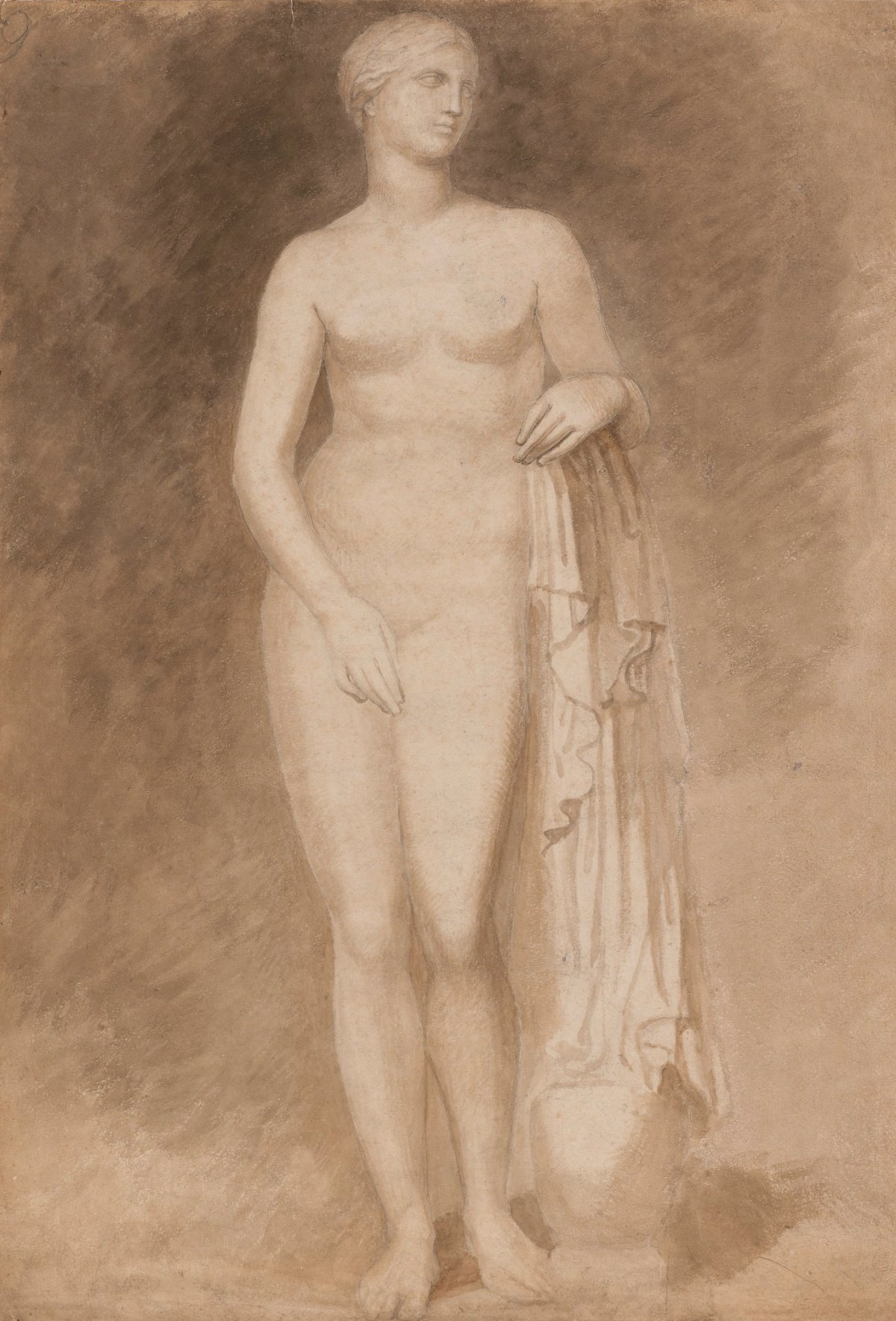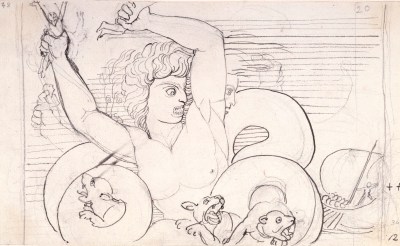
John Flaxman RA, The Braschi Venus, 1811.
Brown wash over pencil on cream wove paper. 738 mm x 638 mm. © Photo: Royal Academy of Arts, London.
This image is not available to download. To licence this image for commercial purposes, contact our Picture Library at picturelibrary@royalacademy.org.uk
The Braschi Venus, 1811
John Flaxman RA (1755 - 1826)
RA Collection: Art
A drawing in pencil and wash of the sculpture known as the 'Braschi Venus', now in the Glyptothek, Munich.
It is very fitting that this work should become part of the Academy’s Collections as it was produced by Flaxman to illustrate his lectures at the RA following his appointment as the institution’s first Professor of Sculpture in 1810. He chose as his subject the Braschi Venus, a Roman sculpture that is a copy of a lost Greek original by the sculptor Praxiteles. The figure is also known as the Venus of Cnidos or the Knidian Venus and is considered to be a prototype for the more famous Venus de’ Medici. Flaxman discussed the significance of the Braschi Venus in his lectures on both ‘Grecian Sculpture’ and ‘Ancient Art’. In particular, he praised Praxiteles as a sculptor who excelled ‘in the highest graces of youth and beauty’, adding that of all his works this one was ‘said to be more perfect than any other’.
The Braschi Venus was discovered in 1776 just a few decades before Flaxman delivered his lectures. It was found in a vineyard near Rome by the Scottish artist, excavator and dealer Gavin Hamilton, and acquired by the local aristocrat Luigi Braschi Onesti, Duke of Nemi. Flaxman, who lived in Rome between 1787 and 1794, was able to view and make sketches of the sculpture at Braschi’s residence. Years later, about to embark on his first series of lectures, Flaxman researched his topic meticulously. Drawing was an integral part of this process for him and he made numerous preparatory drawings and sketches as well as illustrations. In this case, he returned to his Roman aide-memoires to produce a pencil and wash drawing of one of the celebrated figures he was going to discuss.
During the interval between Flaxman’s return from Italy and his election as the RA’s Professor of Sculpture, he had achieved international fame for his elegant illustrations to Homer’s Iliad and Odyssey. An important group of his original drawings for these outline engravings is also held in the Royal Academy Collections and these works clearly demonstrate the sparing style of linear draughtsmanship that he pioneered. It is interesting to see how he took a completely different and much broader approach when drawing the Braschi Venus, however. This reflects the fact that the image was intended to be viewed from a distance by his audience in the Great Room at Somerset House (now the galleries of the Courtauld Institute of Art). Flaxman illustrations evidently made an impact, to the extent that they even distracted some of his audience from the content of his lectures. In 1823 the architect C.R. Cockerell, for instance, complained that ‘Flaxman’s lectures are literally but the exposition of beautiful drawings’.
Flaxman’s Royal Academy lectures were the first series on the theme of sculpture ever to be given by a British artist. As suggested by Cockerell’s comment above, they received a mixed reception from his contemporaries. The diarist Henry Robinson praised Flaxman’s clarity and distinct enunciation. The Swiss painter Henry Fuseli RA, however, made fun of his straight-laced colleague, likening Flaxman’s grave style to that of a clergyman. Leaving a dinner party to hear Flaxman’s first lecture he declared, "Farewell, friends; farewell, wine; farewell, wit. I must leave you all and hear sermon, the first pronounced by the Reverend John Flaxman’. In retrospect, Flaxman’s lectures are remarkable for their broad perspective. While still insisting on the paramount importance Greek and Roman sculpture, Flaxman nevertheless included examples of Egyptian, Romanesque and Gothic works of art.
Despite all the work that Flaxman put into preparing his lectures, he stated categorically that he would never ‘dare’ to publish the scripts as some of his fellow RA Professors has done. They were published in 1829 three years after his death, featuring a print after this drawing of the Braschi Venus (Plate XXII).
Object details
738 mm x 638 mm
Associated works of art
1 results
Start exploring the RA Collection
- Explore art works, paint-smeared palettes, scribbled letters and more...
- Artists and architects have run the RA for 250 years.
Our Collection is a record of them.




